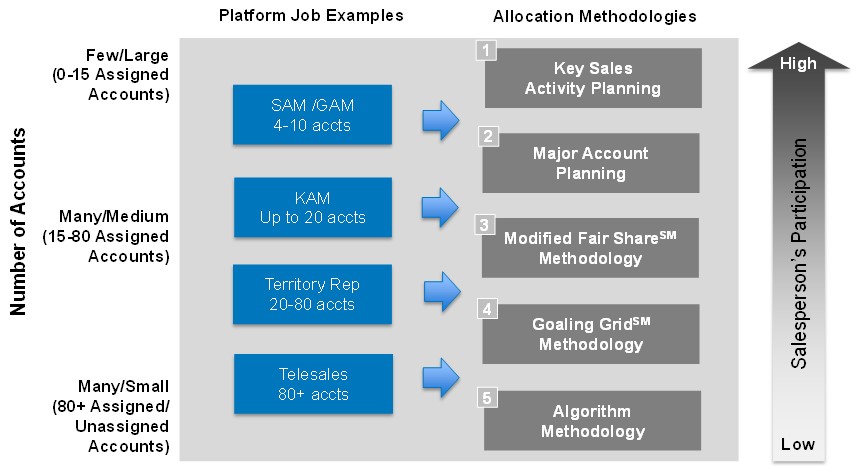How to Select the Right Allocation Methodology

In the fall, most organizations start the annual planning exercise to formulate their sales goals for the next year. Each year, many companies wonder what will work best for this round of quota allocations. As a starting point, the Alexander Group recommends a sober look at last year’s attainments and the first six or nine months of this year. This is a smart first step and serves as a good baseline of how well the company or business unit allocates quotas–at least recently. Balanced and normal quota distributions likely require no change. However, if quota attainments are skewed or multimodal, an assessment of allocation methodology is in order.
Start with Quota Process
It’s the who, what and when of sales quotas. Sales and Finance play a role. What about the actual sales representatives? Field sales involvement in the quota process is important, especially in cases where sales representatives have few accounts, and thus extensive knowledge about customer buying patterns. However, even as the number of accounts per sales person increases and knowledge of specific customers decreases, the sales representative’s input is still quite useful. They provide quality forecast data. Participation in the process often boosts confidence in achieving quotas. Involving sales representatives also facilitates transparency which can further reduce angst around how the “number” is calculated. However, Alexander Group surveys indicate only about one-third of its clients actually use sales representative-based inputs for sales quotas.
Then Select Allocation Methodology
Choose from among standard methodologies (See table below). Correlate the allocation methodology to one or more of the following: platform job type, number of assigned accounts, seller’s knowledge of buyers, customer buying process or revenue segment. One quota methodology does not fit all. Typically there would be at least two methodologies. What’s key is that the number of methodologies should match the number of prevalent sales motions deployed.

Account Managers (fewer than 15 accounts): Strategic account managers (SAMs) and similar account manager roles usually are hybrids of farming/hunting within large accounts and typically have long sales cycles. The good news: the longer sales cycle means these folks start the year with as much as six months of funnel opportunity. There’s half of their annual quota–done. The bad news: they have to figure out the other portions of the quota. Even if everything goes according to plan, the timing of the closes (the long lumpy sales cycles) can be erratic, causing booms and busts across quarters. This is typical. However, over the forecast period, experience shows that AMs sometime make overzealous bets on a handful of opportunities. This is challenging, resulting in bimodal clumping of winners and losers. Clear and consistent definition of funnel stages among AMs can smooth the distribution. Other consistent factors of account planning can help quota allocation, normalizing attainment results within this group. Utilize the first-line managers (FLSMs) here by allowing them full involvement; first-line involvement should be a natural extension of account planning. FLSMs should also be able to reign in and balance some of the AM bets for the coming year. Methodologies for this group include elements of account planning and funnel opportunities.
Territory Representatives (20-80 Accounts): Unlike the assigned handful of accounts of an AM, territory representatives have a longer list of prospects and thus need a different type of allocation methodology. However, in some cases this group does have stratified target lists in which they can have a sub-group of high priority accounts—more of an AM-type motion. Be careful not to apply methodology only by sales role. For larger numbers of accounts, utilize historical data and broader modifiers such as the case with the Modified Fair Share℠ methodology. This methodology uses broader factors to modify historical territory results based on territory factors and on the individual representative’s selling acumen.
Territory-based Modifiers:
- Market Potential
- Market Share
- Competitive Threat
- Customer Wallet Share/Product Potential
- Historical Sales in Territory
- Current and Historical Funnel
- Time in Territory
Individual Representative-based Modifiers:
- Tenure With Firm
- Tenure in Territory
- Tenure in Position
- Sales Experience
- Past Performance/Attainments
Of course, with a decent historical sample, the sales ops team can perform a regression analysis to determine the most relevant modifying factors (and weights) based on past results. Clients rarely do this. However, adoption of this methodology will allow you to make rational judgements, demonstrate competency and fairness to the territory representatives, and build confidence.
Inside Sales (80+ Accounts): For this highly transactional environment, an algorithm methodology is most appropriate. Little is typically known about the individual buyers. Historical sample and macro-based modifiers (not modified locally at the territory level) such as firm pricing, global competition, market trends and GDP are examples of variables. Quota setting for this group of sellers usually reflects company shareholder growth percentage with little over allocation.
Get Help and Start Now
A common point of failure for sales leaders in allocating quotas is procrastination. It’s understandable given the importance of hitting this year’s number before worrying about setting next year’s number. Taking the time to establish a sound plan and methodology pays big dividends. First map out the process, including how to appropriately involve seller input.
Next, choose the right allocation methodology. Successful sales leaders rely on their sales strategy, planning and operations teams to assist with data gathering, analysis and process management. Their support is critical as the larger sales organization focuses on this year’s performance.

Learn More
Learn more about how to assess and redesign your quota programs or contact an Alexander Group Quotas practice leader today.
